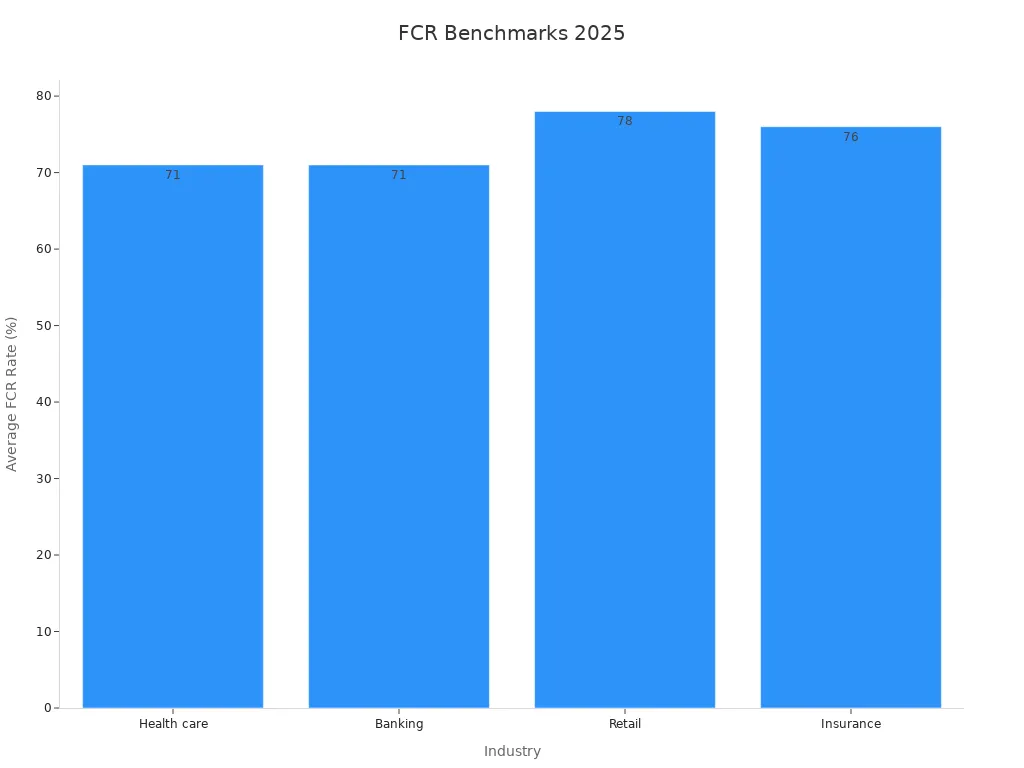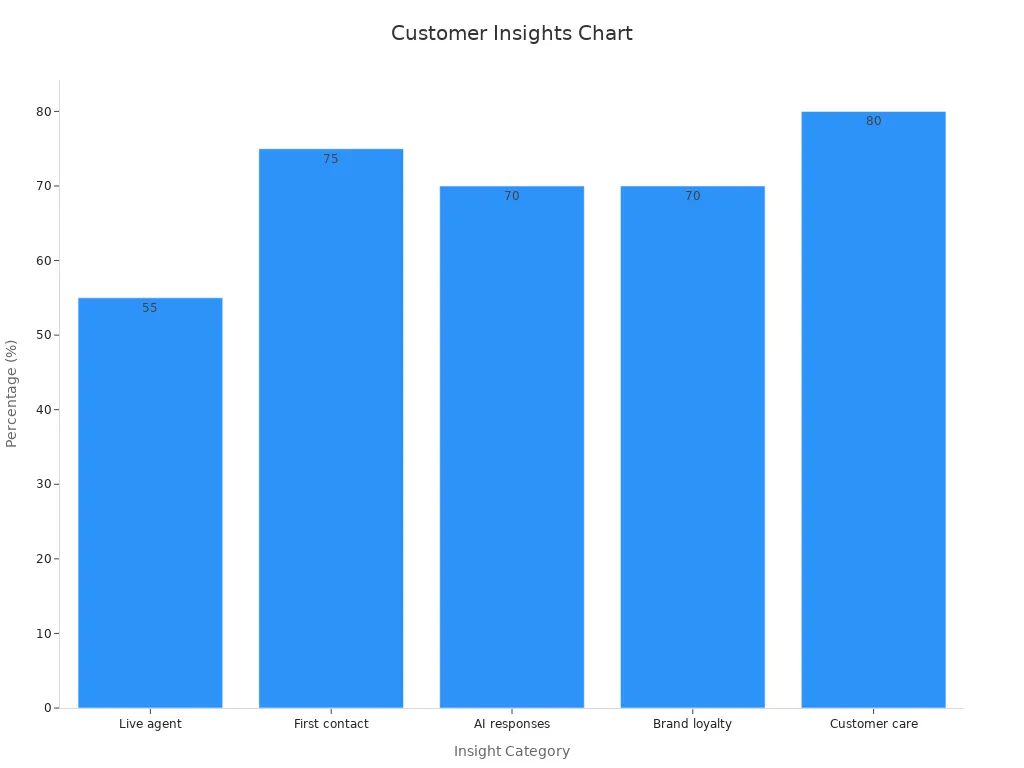How to Measure and Enhance First Contact Resolution in 2025

In 2025, delivering exceptional customer service depends heavily on first contact resolution. When your team resolves issues during the initial interaction, customers feel valued and satisfied. This approach not only builds loyalty but also reduces operational costs. Same day resolution vs first contact resolution debates often highlight the importance of speed, yet FCR stands out for its ability to address problems completely.
Technology now plays a pivotal role in transforming how FCR is measured and improved.
- AI tools provide real-time assistance, enabling agents to handle complex queries confidently.
- Customer journey heatmaps pinpoint common pain points, reducing unnecessary follow-ups.
- Verbatim feedback analysis uncovers the root causes of dissatisfaction, guiding targeted changes.
- Cross-department operating models encourage collaboration, ensuring faster resolutions.
By adopting tools like Sobot and leveraging these advancements, you can redefine the way your team approaches customer service.
Understanding First Contact Resolution (FCR)
What is First Contact Resolution?
First contact resolution (FCR) measures how effectively your team resolves customer issues during the first interaction. It is a key performance indicator in customer service, reflecting both efficiency and quality. To calculate FCR, divide the number of issues resolved on the first attempt by the total number of customer interactions. This metric helps you understand how well your team meets customer expectations.
FCR has evolved significantly over time. Intelligent virtual assistants (IVAs) now handle complex queries, improving resolution rates. Real-time agent assistance powered by AI ensures consistent and accurate responses.
| Benefit | Description |
|---|---|
| Intelligent Virtual Assistants (IVAs) | AI-driven chatbots and voice assistants that manage complex queries, improving FCR rates. |
| Real-Time Agent Assistance | AI support for agents during interactions, enhancing productivity and consistency in responses. |
The Importance of FCR in Customer Service
FCR plays a critical role in customer service. It directly impacts customer satisfaction by reducing the effort required to resolve issues. Customers appreciate quick and complete solutions, which builds trust and loyalty. High FCR rates also improve operational efficiency by minimizing repeat calls and follow-ups.
FCR is not just a standalone metric. It aligns with broader organizational goals and should be reviewed regularly. Integrating data from various departments can help you create strategies that enhance the overall customer experience.
Benefits of High FCR Rates for Businesses and Customers
High FCR rates benefit both businesses and customers. For businesses, they lead to reduced support costs and improved agent efficiency. For customers, they mean fewer frustrations and a smoother experience.
Studies show that high FCR rates can improve customer satisfaction by up to 30%. Customers who resolve their issues in one interaction are more likely to remain loyal. Additionally, a 15% improvement in FCR can reduce repeat calls by 57%, streamlining operations and enhancing satisfaction.
| Evidence Description | Impact on Customer Satisfaction |
|---|---|
| High FCR correlates with positive customer effort and CSAT scores | Customers feel more satisfied when they only need to contact once. |
| 15% enhancement in FCR leads to a 57% decrease in repeat calls | Prioritizing FCR streamlines operations and enhances customer satisfaction. |
| High FCR rates can improve satisfaction by up to 30% | Customers making multiple calls are 15% less likely to be satisfied. |
By focusing on FCR, you can create a win-win situation for your business and your customers.
Measuring First Contact Resolution Accurately

The formula for calculating FCR rates
To measure first contact resolution effectively, you need a clear formula. The standard calculation is:
FCR Rate = (Total Customer Calls Resolved on First Contact / Total Number of First Customer Calls) x 100
This formula provides a percentage that reflects how well your team resolves issues during the first interaction. For example, if your team resolves 800 out of 1,000 customer calls on the first attempt, your FCR rate is 80%.
Accurate measurement requires consistency. Ensure all agents follow the same criteria for marking a call as resolved. Avoid premature closures, as they can distort your first call resolution rate. Regular audits of call logs and agent notes help maintain accuracy.
Tools and software for tracking FCR in 2025
Modern tools simplify measuring FCR. In 2025, software solutions like Sobot offer advanced features to track and analyze first call resolution rates. These tools integrate seamlessly with customer service platforms, providing real-time insights into resolution performance.
Key features of FCR tracking tools include:
- Post-interaction surveys: Gather direct customer feedback to validate resolution success.
- Repeat contact analysis: Identify patterns that highlight unresolved issues.
- Quality monitoring: Review agent interactions to ensure consistent service delivery.
For example, Sobot’s AI-driven analytics can diagnose FCR issues by pinpointing root causes of repeat contacts. Its intuitive dashboard allows you to monitor first call resolution improvement over time, ensuring your team stays on track.
Research shows that tools with high screening uptake (70%) are widely accepted by users. While longer measures like the 9-item FCRI-SF provide detailed insights, brief tools like FCR-1r offer quick and accurate assessments. Both options enhance your ability to measure FCR effectively.
Overcoming challenges in measuring FCR
Measuring FCR comes with challenges. Misdiagnosed resolutions, inconsistent workflows, and reliance on incomplete data can skew results. To overcome these hurdles, adopt a multi-faceted approach:
- Clear troubleshooting workflows: Guide agents toward effective solutions to ensure consistent call resolution.
- Escalation protocols: Transfer complex issues to specialized teams while preserving customer context.
- Customer feedback: Use post-interaction surveys to validate resolution outcomes.
- Repeat contact analysis: Diagnose FCR issues by identifying systemic problems that lead to repeat calls.
- Quality monitoring: Review agent interactions to uncover training opportunities and improve resolution rates.
Balancing FCR with other metrics like Customer Satisfaction (CSAT) prevents undesirable behaviors, such as agents rushing to close cases prematurely. Combining multiple metrics provides a comprehensive view of customer experiences, helping you optimize first call resolution rates.
By addressing these challenges, you can measure FCR accurately and create strategies for continuous improvement.
Benchmarks and Influencing Factors for FCR
Industry benchmarks for FCR in 2025
Understanding industry benchmarks for first call resolution helps you evaluate your performance against peers. In 2025, benchmarks vary across industries due to differences in complexity and customer expectations. For example, the retail sector achieves higher first call resolution rates because of straightforward inquiries, while healthcare and banking face challenges due to the need for accuracy and security.
| Industry | Average FCR Rate | Comments |
|---|---|---|
| Health care | 71% | Indicates room for improvement in resolving patient inquiries on first contact. |
| Banking | 71% | Balances efficiency with the need for security and accuracy. |
| Retail | 78% | Achieves higher FCR rates due to straightforward inquiries. |
| Insurance | 76% | Handles complex policy and claim inquiries with stringent data security. |

By comparing your first call resolution rate to these benchmarks, you can identify areas for improvement and set realistic goals for your customer service team.
Key factors affecting FCR performance
Several factors influence your ability to achieve high first call resolution rates. Process design plays a critical role in reducing customer effort. Streamlined support processes ensure that customers receive quick and accurate resolutions. Staff preparedness is equally important. Regular training equips your team with the skills needed to handle diverse issues effectively. Finally, knowledge management systems provide agents with easy access to accurate information, enabling faster call resolution.
| Key Factor | Description |
|---|---|
| Process Design | Evaluate and streamline service processes to reduce customer effort and complexity. |
| Staff Preparedness | Regularly assess and enhance employee skills and knowledge to ensure effective issue resolution. |
| Knowledge Management | Establish systematic practices for maintaining an accurate and user-friendly knowledge base. |
Focusing on these factors ensures that your team delivers consistent and efficient customer service.
Addressing bottlenecks to improve FCR
Bottlenecks in your support processes can hinder first call resolution. Addressing these challenges requires targeted strategies. An omnichannel approach allows customers to switch between communication channels seamlessly, improving satisfaction and reducing handling time. Data-driven workforce management ensures that calls are routed to the most skilled agents, minimizing wait times and enhancing resolution rates. Additionally, a robust knowledge management ecosystem provides agents with the tools they need to resolve issues quickly.
| Strategy | Impact on FCR and Efficiency |
|---|---|
| Omnichannel Approach | Increases customer satisfaction by 20-30% and reduces handling time, improving FCR rates significantly. |
| Data-Driven Workforce Management | Optimizes staffing and matches calls with skilled agents, minimizing wait times and enhancing FCR rates. |
| Knowledge Management Ecosystem | Organizes and delivers accurate information to agents, reducing handle time and improving FCR rates. |
By implementing these strategies, you can eliminate bottlenecks and achieve high FCR rates, ensuring a smoother experience for your customers.
Strategies to Enhance First Contact Resolution

Agent-level strategies: training and empowerment
Your agents are the backbone of first call resolution success. Empowering them with the right skills and tools ensures they can handle diverse customer issues effectively. Regular training sessions focused on troubleshooting techniques, product knowledge, and communication skills improve their confidence and performance.
For example, role-playing exercises simulate real-world scenarios, helping agents practice resolving complex queries. Pairing this with access to a centralized knowledge base ensures they can retrieve accurate information quickly during interactions.
Empowerment goes beyond training. Allowing agents to make decisions without excessive approvals speeds up call resolution. When agents feel trusted, their motivation and productivity increase, leading to higher first call resolution rates.
Tip: Use post-interaction surveys to identify areas where agents need additional support. This feedback helps you tailor training programs for continuous improvement.
Organizational strategies: process optimization and collaboration
Optimizing your processes reduces friction and enhances resolution rates. Streamlined workflows ensure that customers receive quick and accurate solutions. For instance, implementing clear escalation protocols prevents delays when handling complex issues.
Cross-department collaboration is equally important. When teams like sales, support, and technical departments share information seamlessly, agents can resolve customer inquiries faster. Tools like Sobot’s CRM system facilitate this collaboration by centralizing customer data and interaction history.
An omnichannel approach further improves resolution rates. Allowing customers to switch between communication channels without losing context ensures a smoother experience. For example, a customer who starts a query via live chat can continue it over email without repeating information.
Note: Regularly audit your workflows to identify bottlenecks and inefficiencies. Addressing these issues leads to measurable improvements in first call resolution rates.
Technology-driven solutions: AI, chatbots, and CRM tools
Technology plays a transformative role in improving first call resolution. AI-powered chatbots handle routine inquiries efficiently, freeing agents to focus on complex issues. These chatbots use natural language processing to understand customer queries and provide accurate responses.
CRM tools like Sobot’s platform enhance resolution rates by centralizing customer data. Agents can access interaction histories, preferences, and previous resolutions, enabling personalized and efficient service. Predictive analytics within CRM systems also help anticipate customer needs, reducing repeat contacts.
Research highlights the effectiveness of these solutions:
| Evidence Type | Description |
|---|---|
| Research Focus | Effectiveness of AI-powered chatbots in CRM systems |
| Methodology | User surveys, log analysis, agent feedback |
| Key Metrics | Successful chatbot resolutions, first contact resolution rates, customer satisfaction ratings, impact on agent workload |
Additionally, statistics validate the impact of AI and CRM tools:
| Statistic | Insight |
|---|---|
| ~55% of surveyed customers | Interacting with a live agent delivers the quickest solution. |
| ~75% of customers | First-contact resolution is the most important factor in improving customer experience. |
| ~70% of customers | AI or chatbots contribute to faster responses. |
| ~70% of customers | More loyal to brands providing personalized experiences. |
| ~80% of respondents | Recommended a company based on top-notch customer service. |

By integrating AI, chatbots, and CRM tools into your customer service strategy, you can achieve significant improvements in first call resolution rates. These technologies not only enhance efficiency but also elevate the overall customer experience.
Advanced Approaches to FCR in 2025
Leveraging AI for predictive issue resolution
AI has revolutionized customer support by enabling predictive issue resolution. Advanced AI systems analyze historical data to anticipate customer needs before they even contact your customer support team. For example, AI can detect patterns in previous interactions and proactively suggest solutions to agents or customers. This reduces the time spent diagnosing issues and increases first-contact resolution rates.
AI agents trained on company-specific data achieve up to 91% first-contact resolution. This minimizes repeat contacts and enhances customer loyalty. Tools like Sobot integrate AI seamlessly into your workflows, offering predictive insights that empower your team to resolve issues efficiently.
Tip: Use AI-driven dashboards to monitor recurring issues and adjust your processes accordingly. This ensures your support remains proactive and effective.
Using predictive analytics to improve FCR rates
Predictive analytics takes AI capabilities further by providing actionable insights based on customer behavior. These models analyze data from multiple sources, including past interactions, purchase history, and demographic information. By identifying trends, predictive analytics helps your team anticipate customer needs and resolve issues during the first interaction.
For instance, predictive models can flag customers likely to experience technical difficulties based on their product usage patterns. Your support team can then reach out proactively or prepare solutions in advance. This approach not only improves first-contact resolution rates but also strengthens customer loyalty.
Sobot’s predictive analytics tools simplify this process. They provide real-time insights into customer behavior, enabling your team to deliver personalized and efficient support.
Integrating customer feedback for continuous improvement
Customer feedback is a goldmine for improving first-contact resolution. Post-interaction surveys and feedback forms reveal whether customers felt their issues were resolved completely. This data helps you identify gaps in your support processes and refine your strategies.
For example, if feedback highlights recurring dissatisfaction with a specific product, your team can investigate the root cause and implement targeted solutions. Regularly analyzing feedback ensures your support evolves to meet customer expectations.
Sobot’s feedback integration tools streamline this process. They collect and analyze customer input, providing actionable insights that drive continuous improvement. By addressing feedback promptly, you enhance customer loyalty and ensure your support remains top-notch.
Note: Encourage customers to share honest feedback by making surveys quick and easy to complete. This increases participation and provides valuable insights for your team.
First Contact Resolution (FCR) remains a cornerstone of exceptional customer service. It boosts customer satisfaction, reduces operational costs, and strengthens loyalty. To improve FCR, focus on accurate measurement, agent training, and streamlined processes.
Key Takeaways:
- Use tools like AI-driven analytics and CRM platforms to track and enhance FCR.
- Empower agents with training and decision-making authority.
- Regularly analyze customer feedback to refine your strategies.
By adopting these steps and leveraging modern technology, you can ensure long-term success and deliver a seamless customer experience.
FAQ
What is the ideal first contact resolution rate for customer service?
An ideal first contact resolution rate varies by industry. However, achieving 75-85% is a strong benchmark. It reflects your ability to resolve customer issues efficiently, enhancing satisfaction and loyalty.
How does first contact resolution impact customer service costs?
Higher first contact resolution rates reduce repeat calls and follow-ups. This lowers operational costs by minimizing the time and resources spent on unresolved issues. Efficient service also improves agent productivity.
Can small businesses improve first contact resolution with limited resources?
Yes, small businesses can enhance first contact resolution by training agents, streamlining processes, and using affordable tools like AI chatbots. These strategies ensure efficient service without requiring significant investments.
How does technology improve first contact resolution?
Technology like AI, chatbots, and CRM systems streamlines issue resolution. These tools provide agents with real-time insights and automate repetitive tasks. This ensures faster and more accurate service for customers.
Why is customer feedback important for first contact resolution?
Customer feedback highlights gaps in your service processes. It helps you identify recurring issues and refine strategies. Regularly analyzing feedback ensures continuous improvement in resolution rates and overall customer satisfaction.
See Also
A Guide to Successfully Implementing Omnichannel Contact Centers
Best Reviewed Contact Center Solutions for the Year 2024
Essential Best Practices for Quality Management in Call Centers
Enhancing Call Center Performance Through Effective Monitoring Techniques
Ten Strategies to Improve Customer Satisfaction in Live Chat
